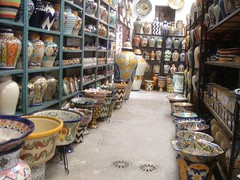Dolores Hidalgo, San Miguel, Queretaro
By nancy - Posted on May 1st, 2007
Tagged: Inuvik to Ushuaia
During the next couple of weeks we visited three other colonial cities: San Miguel de Allende, Dolores Hidalgo and Queretaro all which have important connections to the Mexican War of Independence back in 1810. All the cities benefited from the silver mines; Wonderful churches and other colonial buildings were built as a result of gold and silver mining in the area over 250 years. The cities all were places that fought the Spanish for the right to govern themselves.
San Miguel has the most active interesting plaza. I sat in the plaza and painted well into the night. While drawing I listened to various musical bands serenading the people hanging around the plaza. San Miguel has a large gringo population that has retired to this area and has influenced the culture of the area. As a result there is a huge library with wide selection of books in multiple languages, a very active art community and more old women beggars then any place else.

Talavera pottery in Dolores Hidalgo
Dolores Hidalgo is more of a small town, but it's famous for being the place where the priest Miguel de Hidalgo issued the "Grito" or "Cry" that started the Mexican War for Independence in 1810. The priest Hidalgo had also started the ceramics industry in the town as a way to improve the life of the indigenous peoples, and "Talavera" pottery is still being produced here. We toured several ceramic factories which make the handmade talavera pottery. We even went in the back of the factory and saw 5 of the artists painting the detailed designs on the pottery. I can understand why someone would choose to use the pottery and painted tiles to adorn their houses with this very typical Mexican handcrafted work. We did visit two great museums: the National Independence Museum and the Dolores Hidalgo Museum really explained who the key players where in the War of Independence and the reason behind the historical event. The fact that the explanations were in Spanish and English helped me greatly.
Queretaro was the last colonial city on ride through the "Bajio" and the most memorable one because of the friends we developed while there. We met two cyclists who cycled from Queretaro to the bottom of South America (where we're going). We spent Friday night talking with Andrei and Dulce about life as a cyclist. On Sunday we all spent the day at the hot springs just on the outskirts of the town of San Miguel. We all returned to the city and met the Belgium couple, Lorenzo and Sarah whom we met at the hot springs. Dulce, Andrei, and their son Emiliano gave us a full walking tour of this great city which has an ancient church at every corner. After the walking tour we enjoyed drinks at the outdoor café on the plaza across from the Government Palace (Palacio De Gobierno) The private tour ended with a night drive up to highest point overlooking the twinkling lights and the ancient 12 kilometer aquaduct that still carries clean water to the city.
As we cycled away from the Queretaro, we reflected on our visit. I felt the place had a heart and soul and a history of caring for the people. Andrei and Dulce with have heart and soul and shared this with us and provided a view of their city which we could not have had otherwise. We'll try to publish their account of their amazing journey.
San Miguel has the most active interesting plaza. I sat in the plaza and painted well into the night. While drawing I listened to various musical bands serenading the people hanging around the plaza. San Miguel has a large gringo population that has retired to this area and has influenced the culture of the area. As a result there is a huge library with wide selection of books in multiple languages, a very active art community and more old women beggars then any place else.

Talavera pottery in Dolores Hidalgo
Queretaro was the last colonial city on ride through the "Bajio" and the most memorable one because of the friends we developed while there. We met two cyclists who cycled from Queretaro to the bottom of South America (where we're going). We spent Friday night talking with Andrei and Dulce about life as a cyclist. On Sunday we all spent the day at the hot springs just on the outskirts of the town of San Miguel. We all returned to the city and met the Belgium couple, Lorenzo and Sarah whom we met at the hot springs. Dulce, Andrei, and their son Emiliano gave us a full walking tour of this great city which has an ancient church at every corner. After the walking tour we enjoyed drinks at the outdoor café on the plaza across from the Government Palace (Palacio De Gobierno) The private tour ended with a night drive up to highest point overlooking the twinkling lights and the ancient 12 kilometer aquaduct that still carries clean water to the city.
As we cycled away from the Queretaro, we reflected on our visit. I felt the place had a heart and soul and a history of caring for the people. Andrei and Dulce with have heart and soul and shared this with us and provided a view of their city which we could not have had otherwise. We'll try to publish their account of their amazing journey.

